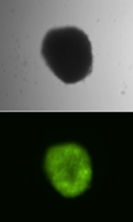Lockdown for genome parasites
Researchers uncover an ingenious mechanism by which Arabidopsis safeguards the integrity of its genome
Advertisement
Is it possible for one single gene product to silence undesirable genetic elements? Can such a strong effect be seen in the regulation of Transposable Elements (TEs), or genome parasites? If yes, how does this gene product singlehandedly keep transposons in check? New research from Frédéric Berger’s group at GMI provides answers to all of these questions and dissects a mechanism of gene silencing that has long remained shrouded in mystery.
Genome parasites
Although jumping genes promote genomic variation at an evolutionary scale, their effects on an individual organism are massively deleterious. If left unregulated, they could give rise to genome instability and various diseases. In the model plant Arabidopsis, loss of function of one single gene product identified 30 years ago, Decreased DNA Methylation I (DDM1), was shown to result in vast and uncontrollable transposition events. DDM1 is a chromatin remodeler that helps keep DNA tightly packed to silence TEs, but the underlying mechanism how DDM1 silences TE was still unknown.
Trapped before they jump!
The team around GMI group leader Frédéric Berger, with co-first authors Akihisa Osakabe and Bhagyshree Jamge, describe the molecular mechanism of action of DDM1. They show that DDM1 targets TEs by binding H2A.W, a variant of the histone H2A, one of the building blocks that coat DNA to form the condensed and tightly packed heterochromatin. The team demonstrates that the deposition of H2A.W by DDM1 on DNA regions rich with TEs is not only necessary, but also sufficient to remodel the chromatin and silence the TEs. Importantly, the team shows that this mechanism dominates by far other known TE silencing mechanisms in Arabidopsis and that the effect of DDM1 is specific for jumping genes with intact transposing potential, i.e., potentially mobile TEs. “Transposons integrate the genome and thus share chromatin with the host. They can be viewed as enemies hiding in houses. What makes these houses distinct from those hosting protein coding genes? – The material used to build these houses is different: it enshrines transposons such that they can’t go out and multiply,” says Frédéric Berger. The silencing mechanism described does not affect fragments of jumping genes that have lost their ability to transpose independently, neither does it affect protein coding genes. Frédéric Berger does not hesitate to describe the mechanism with some humor: “Basically, the strategy is: enshrine your enemy in building blocks made of special material and send him to hell!”.
Sent to hell packaged by DHL
The association with hell comes from “Hells”, the name of the human ortholog of Arabidopsis DDM1. The researchers propose a new class of chromatin remodelers, grouping DDM1 and Hells together with their mouse ortholog Lsh, that they term “DHL”. The DHL chromatin remodelers show conserved binding sites for the histone variants. In addition, all three remodelers have been associated with genomic instability and disease in their respective organisms, in case mutations lead to their loss of function.
DHL remodelers control transposons dynamics
DDM1 is the key factor in “camouflaging” TEs away from the transcriptional machinery by utilizing special “building blocks” that prevent their recognition. Asked about the broader impact of this novel mechanism, Frédéric Berger states: “DDM1 orthologs in mammals deposit the H2A.W ortholog variant macroH2A, which has been implicated in various human syndromes and cancers. Better insight into the mechanism of action of this class of histone binding proteins will advance our understanding of genome dynamics with impacts on medicine and evolution”.
Engineering silencing mechanisms in yeast
Frédéric Berger, who has received funding from the “1000 Ideen” grant for high-risk research from the Austrian Science Fund (FWF), is already investigating emergent properties of these histone variants and chromatin remodelers and engineering novel silencing pathways in yeast based on the Arabidopsis H2A.W and DDM1.























































